Abstract
Large-scale clean-heating renovations are being carried out in northern China as part of important measures to optimize energy infrastructure, improve the atmospheric environment, and minimize peak CO2 emissions. Because rural areas in the urban–rural fringe are close to the city center, they have several advantages in centralized heating reforms, but there are no effective means to measure whether a transformation is economical or has good environmental effects. In this paper, based on an actual reconstruction project, 100 typical households were selected for a related test. These typical households evinced convergence and possessed certain regional characteristics; therefore, the applicability of the models had certain limitations. To make sure that the relevant factors were fully considered in establishing the model, a prediction model group was established regarding heat consumption in winter (four models in total) that could predict the actual effect well. Lastly, the authors used the model group to calculate economic effects and CO2 emission reduction in rural heating transformations in Beijing under different heating methods.
1. Introduction
Addressing climate change is a global challenge and requires responses from all sectors and all aspects of society [1]. The rapid growth of global energy use has raised widespread concerns about resources and the environment [2]. The heat-energy consumption of northern rural buildings in China accounts for over 60% of the total energy consumption of buildings [3,4]. Currently, household heating systems in rural China primarily use coal [5], and coal used for space heating is mainly burned in small coal-burning boilers or coal furnaces [6]. Poor energy efficiency in coal-burning boilers has created a huge amount of primary energy waste and provides inadequate indoor thermal comfort, which has caused severe health and safety problems for farmers [7,8]. Large-scale clean heating transformation is an important potential measure for optimizing regional energy infrastructure and improving the quality of the atmospheric environment [9,10]; at the Chinese government’s initiative, several Blue-Sky Protection Campaigns are being launched in many northern provinces to control air pollution and maintain national health [11,12].
The Chinese government has promoted a “coal-to-electricity” policy since 2013 and implemented it in Beijing’s rural regions to further eliminate coal usage and achieve “zero coal villages” [13,14]. However, judging by the results of current heating transformation initiatives in rural areas, a single transformation policy has not achieved significant results, and in the meantime, many other problems have arisen. Therefore, different transformation-based technical roadmaps should be developed. In short, Beijing is trying to draw lessons from its urban heating experience to explore the feasibility of centralized heating in its rural areas. In addition, the question of how to forecast economic benefits and CO2 reduction from heating reforms needs to be studied in depth.
With the proposal of China’s 3060 carbon dioxide emission peak and carbon neutrality goal, heating in northern areas has become an important field in carbon reduction. Can the urban–rural fringe reduce CO2 emissions and the environmental pollution caused by coal boilers with upgrades to central heating? Given these issues, a sound way of proceeding would be to establish a mathematical model to truly reflect the heating situation and then combine the results with relevant standards and parameters to analyze the CO2 emissions before and after heating upgrades are implemented.
2. Literature Review
M. Kleinebrahm et al. [15] expanded the highly transferable energy system optimization model RE3ASON. In their study, taking into account different retrofit rates, retrofit depths, and modernization rates for heating technologies, additional technologies such as heat recovery units (HRU) and air conditioners (AC) were examined. In total, 192 building stock transformation scenarios were created for an exemplary case study of the German city of Karlsruhe. Y. Chen et al. [16] established an energy and exergy analysis based on a mathematical model of a solar and biogas hybrid heating system using a MATLAB/Simulink platform and proposed a corresponding operation control strategy for it. In addition, they calculated its energy and exergy. A. Al-Sakkaf et al. [17] used Design Builder software (version 4.5.0.148) to evaluate energy performance in passive design scenarios, which encompassed double low-E glass; double reflected glass; double low-E glass and a double wall with an air gap; double low-E glass and a double wall with thermal insulation; double low-E glass and a double wall with lightweight thermal insulation; double low-E glass and a double wall with sprayed foam insulation; double reflected glass and a double wall with an air gap; double reflected glass and a double wall with thermal insulation; double reflected glass and a double wall with lightweight thermal insulation; and double reflected glass and a double wall with sprayed foam insulation. Ultimately, they concluded that using double low-E glass and applying polystyrene thermal insulation to a double wall could enhance thermal comfort inside a building and, respectively, reduce energy performance and CO2 emissions by 17% and 9%. D. Bienvenido-Huertas et al. [18] designed a set of building models that evaluated useful energy demand, obtained based on the thermal requirements of relevant envelopes in South America (i.e., Chile, Argentina, and Brazil) and Europe (i.e., France, Portugal, and Spain). They conducted 792 simulations with Energy Plus, considering 12 different dwelling typologies in 66 climate zones, and concluded that performance tendencies are clearly different between South American and European countries, with the latter having the lowest energy demands. D. Bienvenido-Huertas et al. [19] distinguished four zones with the possibility of applying adaptive strategies in the Andalusian geographical region, predicting three climate-change scenarios (i.e., RCP 2.6, RCP 4.5, and RCP 8.5) in each decade (from 2030 to 2100). This was based on simulating 6528 cases of representative social housing, with the data assessed from the point of view of fuel poverty risk.
3. Analysis of Modeling Methods and Heating Characteristics
3.1. Conventional Statistical Modeling Methods
(1) Average Index Evaluation Analysis
An average index evaluation analysis is a very important comprehensive method in statistics. It is a comprehensive indicator reflecting, on a general level, the quantitative characteristics of an overall unit at a certain time or in a certain place or condition. Ordinary indexes include arithmetic and geometric means, harmonic means, the weighted average, etc.
(2) Time Series Analysis
This method, based on the passage of time, studies the development trends of entities at different times, explores their evolutionary trends and laws over time, and predicts the quantity and scale of entities in the future.
(3) Index Analysis
This method is commonly used in economic analyses, mainly used to reflect the relative change rate. An index analysis usually uses an existing index formula to substitute a large amount of data for an analysis, such as the Malmquist index model, etc.
(4) Sampling Analysis
This method is based on random sampling using the principle of mathematical statistics, represented by the quantitative characteristics of sampled units, and makes a quantitative estimation and inference of a population with a certain degree of reliability.
(5) Regression Analysis
A regression analysis refers to the general quantitative relationship between variables. Based on the manifestation of correlations between phenomena, a straight line or curve is used to express the general quantitative relationship of changes between independent variables and dependent variables. This method establishes the numerical equation of this line or curve to obtain the general correlation value between variables.
As rural heating energy consumption is affected by outdoor weather, exterior wall structures, heating methods, and other factors, a regression analysis can be judged to be the most appropriate method.
3.2. Research Framework
The research framework and steps in developing the model are shown in Figure 1.

Figure 1.
Research framework and steps in developing the model.
3.3. Analysis of Building and Heating Characteristics
(1) Building Characteristics
Driven by an interest in house leasing, most of the houses in the study area have more than three floors, with a gross floor area of 300–1000 m2. Compared with traditional rural areas in northern China, the area has a large number of houses, a large building area, and high building heights.
(2) Heating Characteristics
Winter in the cold northern regions of China lasts 5 to 6 months [20,21]. Although most buildings in the urban area of Beijing have district heating, the rural areas in the urban–rural fringe still use the traditional independent boiler heating method, and the heating temperature is controlled by the amount of coal burned by residents [22].
(3) Building Location Features
The rural areas of Beijing’s urban–rural fringe are close to the city center and have the advantage of being a short distance away from their heating source, which means that there have been few investments in laying heating pipes. Residents who live here have a higher level of consumption, and this guarantees that there will be heat-charge collection reductions after heating upgrades are implemented.
4. Analysis of Heat-Affecting Factors and Testing Contents
4.1. Investigation of Heat-Affecting Factors
To establish our heat consumption model, it was necessary to investigate the factors that affect heat consumption and conduct a preliminary screening of these factors. One hundred rural buildings were investigated, and the relevant factors are summarized in Table 1.

Table 1.
Summary of investigated factors.
The fourteen factors can be classified into four categories: controllable, uncontrollable, directly available, and indirectly available. Controllable factors refer to factors that can be modified manually and subjective factors. Uncontrollable factors refer to factors that cannot be modified manually and objective factors. Directly available factors refer to digital factors that can be directly obtained via investigation or testing. Indirectly available factors refer to non-digital factors. The best factors for modeling are uncontrollable and directly available factors.
We chose uncontrollable and directly available factors because they are inherent, objective, and digital. At the same time, because these factors are uncontrollable, fraud can be avoided. The classification factors are summarized in Table 2.

Table 2.
Classification factors.
4.2. Analysis of Affecting Factors
Based on Table 2, the first affecting factors involved in the model were the indoor temperature, outdoor temperature, gross floor area, and gross window area. However, other important factors that cannot be used first but have a significant impact on heat consumption also need to be considered.
(1) Forms of Heating Systems
According to the national standards of the People’s Republic of China set by the “Design code for heating ventilation and air conditioning of civil building”, GB 50736-2012, when a system uses radiant floor heating, the water supply temperature can be 2 °C lower than the heat produced by the radiator. Therefore, the forms of heating systems must be considered.
(2) Wall Construction
Rural buildings in China are mostly built with “red bricks”. The size of “red bricks” is 240 mm × 115 mm × 53 mm. Because of different placement methods, the walls of buildings can have two levels of thickness: 370 mm and 240 mm. The heat transfer coefficient is directly affected by the thickness of a wall, so wall construction was not considered.
(3) Window Construction
Single glazing, double glazing, and multi-layer glazing have a major influence on the heat transfer coefficient. Like wall construction, window construction was not considered.
(4) Exterior Wall Insulation
Whether a building has exterior wall insulation is also an important factor affecting the heat transfer coefficient. Although rural buildings in China generally do not have wall insulation, to ensure modeling accuracy, exterior wall insulation was not considered.
4.3. Testing Method for Affecting Factors
Based on the results of the analysis in Section 4.2, eight affecting factors were determined. Nearly 100 buildings were chosen for investigation and testing, and the requirements and methods are summarized in Table 3.

Table 3.
Investigation and testing requirements and methods for affecting factors.
4.4. Analysis of Testing Results and Selection of Affecting Factors
(1) Factors that Can Directly Participate in Modeling
Based on the results of the analysis in Section 4.2, the indoor temperature and outdoor temperature were found to directly affect heat consumption, so they can directly participate in modeling. The gross floor area and gross window area are both “area” factors, so a strong correlation judgment is required to determine whether these two factors can participate in modeling. The correlation between GWA and GFA is shown in Figure 2.
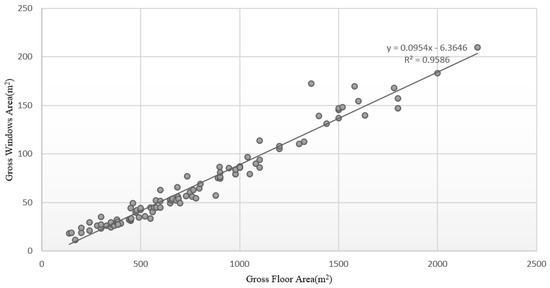
Figure 2.
Correlation between GWA and GFA.
Figure 2 shows that GWA and GFA have a strong correlation; the R2 value was 0.959—very close to 1. Thus, only one factor should be selected to participate in modeling. As GFA is more often used in modeling, GFA participates.
(2) Other Important Factors
Other important factors include the forms of heating systems, wall construction, window construction, and exterior wall insulation. The survey results for the above four factors regarding the one hundred buildings chosen for investigation and testing are shown in Figure 3.
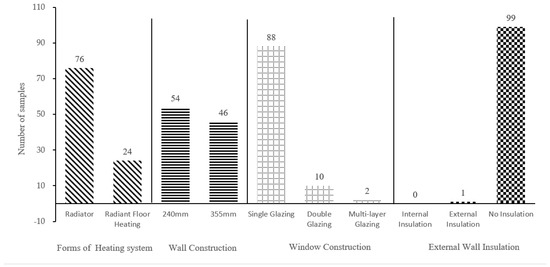
Figure 3.
Investigation and testing results for other important factors.
From the survey’s investigation and testing results, it can be seen that nearly 90% of the buildings had single glazing, and about 10% of the buildings had double glazing or multi-layer glazing. Furthermore, the proportion of buildings with no insulation was 99%; only one building had external insulation. Therefore, this paper does not consider these two factors in the model.
Figure 3 shows that about three-quarters of the buildings’ systems use radiators, and about a quarter of the buildings’ systems use radiant floor heating. In terms of wall construction, 240 mm wall thickness buildings account for about 54%, and 370 mm wall thickness buildings account for about 46%. These two factors need to be further analyzed to determine whether they should be considered in the model.
To determine whether the factor relating to the forms of heating systems should be considered, a comparative experiment was conducted. To ensure the scientific nature of this analysis, other affecting factors had to remain constant. In this comparative experiment, contrast samples had the same testing conditions: wall construction, 240 mm; window construction, single glazing; no insulation; and indoor temperature, 17 °C. To avoid the impact of GFA, three groups with different GFA values were selected (300–350 m2, 500–500 m2, 900–1000 m2). Testing took 24 h over 3 days, and the results are summarized in Table 4.

Table 4.
Testing results of the comparative experiment on forms of heating systems.
Table 4 shows that radiant floor heating systems can reduce heat consumption by about 20–30% under the same conditions as other affecting factors compared with radiator heating systems. Therefore, the forms of heating systems are an important affecting factor, which should be considered when modeling.
To determine if the wall construction factor should be considered, another comparative experiment was conducted. As with forms of heating systems, this comparative experiment’s contrast samples used the same testing conditions: forms of heating systems, radiators; wall construction, 240 mm; window construction, single glazing; no insulation; and indoor temperature, 17 °C. To avoid the impact of GFA, three groups with different GFA values were selected (300–350 m2, 500–500 m2, 900–1000 m2). The testing took 24 h over 3 days, and the results are summarized in Table 5.

Table 5.
Testing results of the comparative experiment on wall construction.
Table 5 shows that different wall constructions have a very low impact on heat consumption under the same conditions as other affecting factors. The thicker the wall is, the less heat consumption accuracy. Through exploration, we found that the air tightness of rural housing is generally poor, and large ventilation areas are created in walls so that a chimney can lead outdoors to avoid CO poisoning. Therefore, wall construction will not be considered in the model.
5. Establishment and Verification of Heat Consumption Prediction Model Group
5.1. Process of Building the Model Groups
(1) Non-digital Factors
Forms of heating systems are a non-digital factor that could not directly participate in the modeling process. Thus, to make sure the model is accurate and reliable, it was necessary to establish a radiator model and a radiant floor heating model.
(2) Data Characteristics
In the process of modeling, we found that the effect of the model was poor. It could not pass the t-test or F-test, and the adjusted R2 value was much less than one. Thus, the data characteristics of daytime and nighttime were further analyzed. The effects of different forms of heating systems are shown in Figure 4a,b.
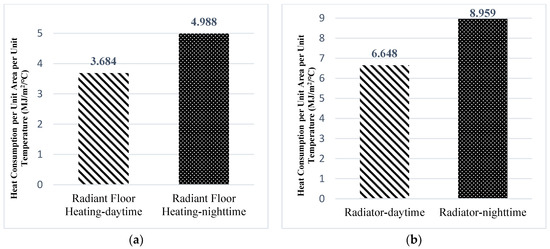
Figure 4.
(a) Comparison of radiant floor heating; (b) comparison of radiators.
Figure 4a,b show that there was a large gap in heat consumption per unit per temperature between daytime and nighttime. The data during the daytime were significantly lower than those of nighttime. The deviation in radiant floor heating systems was 26.1%, and the deviation in radiator systems was 25.8%. Therefore, daytime and nighttime should also be considered in the model.
In summary, this paper established a prediction model group for heat consumption that includes the following four models: Radiator—Daytime Model, Radiator—Nighttime Model, Radiant Floor Heating—Daytime Model, and Radiant Floor Heating—Nighttime Model.
5.2. Establishment and Validation of the Prediction Model Group for Heat Consumption
The data-driven approach has advantages in mining actual loads [23]. Using SPSS, the prediction model group for heat consumption in this paper drew lessons from the US Energy Star benchmarking tool in establishing the measured data.
GFA was the primary factor directly affecting heat consumption. Normally, the larger the GFA, the higher the heat consumption, and the influence of other factors cannot be compared. Thus, to prevent GFA from affecting the accuracy of the models, heating consumption per unit area was used to establish them.
When establishing the model, the testing result should first be sifted, and abnormal data should be deleted. Secondly, each model should pass statistical testing criteria, including R2 (goodness-of-fit), the F-test, the t-test, the residual plot, and the P-P plot. The data filter and trimness results are shown in Table 6. The statistical testing results of each model are shown in Table 7, Table 8 and Table 9 and Figure 5 and Figure 6.

Table 6.
The data filter and trimness results.

Table 7.
Adjusted R2 of each model.

Table 8.
F-test of each model.

Table 9.
t-test of each model.
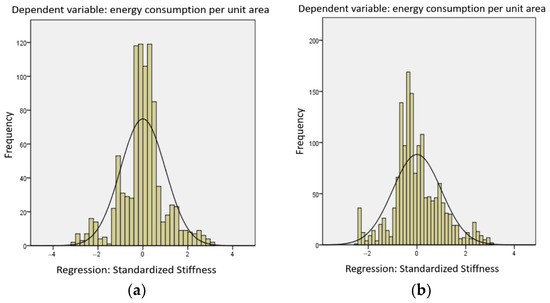
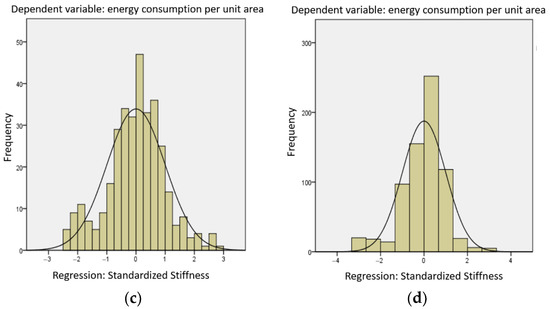
Figure 5.
Model residual plot: (a) Radiator—Daytime; (b) Radiator—Nighttime; (c) Radiant Floor Heating—Daytime; (d) Radiant Floor Heating—Nighttime.
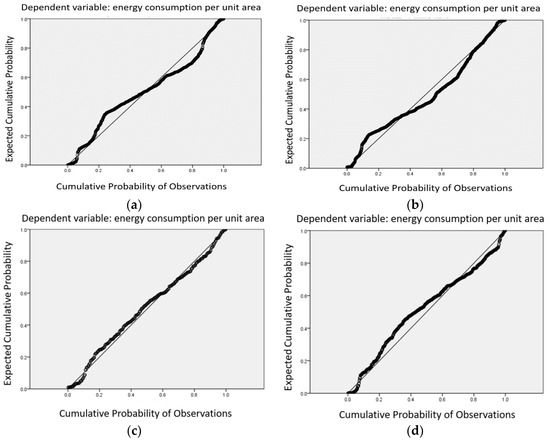
Figure 6.
Model P-P plot: (a) Radiator—Daytime; (b) Radiator—Nighttime; (c) Radiant Floor Heating—Daytime; (d) Radiant Floor Heating—Nighttime.
Table 7 shows the adjusted R2 of the nighttime models, and both were above 0.8. The adjusted R2 of the Radiant Floor Heating—Nighttime Model was close to 0.9, and the adjusted R2 values of the daytime models were around 0.7. The goodness-of-fit of the four models was close to one, which proved that the modeling result was good.
Thus, the heat consumption prediction model group was established, as shown in Equation (1) to Equation (4):
(1) Radiator—Daytime Model:
(2) Radiator—Nighttime Model:
(3) Radiant Floor Heating—Daytime Model:
(4) Radiant Floor Heating—Nighttime Model:
- —Hourly heat consumption per unit area (kJ/m2);
- —Hourly average indoor temperature (°C);
- —Hourly average outdoor temperature (°C).
5.3. Validation of the Heat Consumption Prediction Model Group
Statistical validation was required to determine whether the regression results of each model were excellent. The F-test, the t-test, the residual plot test, and the P-P plot test were carried out for each model.
The results of the F-test are shown in Table 8. The results of the t-test are shown in Table 9. The results of the residual test are shown in Figure 5. The results of the P-P plot test are shown in Figure 6.
Table 8 shows that all four models passed the F-test; that is, the F-values were all larger than the corresponding Fα values; the larger the F-value, the better the fitting result.
The t-test compares the p-values of independent variables. In general, the default p-value for statistics is 0.05. Table 9 shows that the p-values of the independent variables of each model were obviously less than 0.05, and thus, all models passed the t-test.
From the comparisons in Figure 5a,d, it can be seen that the residual distributions of the four models coincided with a normal distribution, indicating that the fitting results of the models were good.
By comparing the P-P diagrams of the models in Figure 6, it can be seen that the expected cumulative probability and observed cumulative probability of the standardized residuals of each sample in the four models were basically on the 45° line, indicating that the model fitting effects were good.
Based on the statistical validation, it can be concluded that the four models we established were excellent.
6. Analysis of the Economy and Carbon Reduction in Rural Centralized Heating Upgrades
6.1. Heat Consumption Analysis of Different Heating Methods
Generally, rural areas show higher levels of energy poverty than urban areas and a higher number of partially used or unoccupied dwellings [24]; therefore, intermittent heating is the most common method. As farmers’ incomes increase, future energy policies should pay more attention to the effect of intermittent heating on both the cost and quality of heating systems, as well as its different regional effects [25]. Therefore, continuous heating methods may become common. In summary, it is necessary to calculate the heat consumption rate of different heating methods before analyzing economic and environmental effects.
There are 10 villages ready for centralized heat upgrades. There are 2900 buildings; the average household area is about 950 m2; 30% use radiant floor heating; 70% use radiator heating; the average indoor temperature is 16.5 °C; and the actual monitoring outdoor temperature data are known, calculated based on the whole heating season (15 November 2021–15 March 2022). The duration of intermittent heating methods is 21 h per day (non-heating times: 3:00–4:00, 9:00–10:00, 15:00–16:00); the continuous heating methods last 21 h per day. The heat consumption rates of different heating methods are summarized in Table 10.

Table 10.
Heat consumption rates of different heating methods.
6.2. Analysis of CO2 Reduction in Rural Centralized Heat Upgrades
Based on the heat consumption rates of different heating modes and the local Beijing standard set by “Requirements for Carbon dioxide emission accounting and reporting Heat production and supply enterprises”, DB11/T 1784—2020, the CO2 emission rates of different heating methods were calculated. The formula for calculating CO2 emissions is shown in Equation (5). Specific and detailed results are shown in Table 11.

Table 11.
Reference values and CO2 emission calculations.
- —CO2 emissions (ton);
- —Heat consumption (GJ);
- —Efficiency of boiler;
- —Carbon content per unit of calorific value (ton/GJ);
- —Carbon oxidation rate.
Based on this calculation, the CO2 emission rate of small coal-burning boilers was 83,464.0 t, and the emission rate of intermittent heating from centralized heat is 66,600.2 t. The CO2 emissions were reduced by 16,863.8 t, with an emission reduction rate of 20.2%. The CO2 emission rate of continuous heating from centralized heat was 50,499.2 t. CO2 emissions were reduced by 32,964.7 t, with an emission reduction rate of 39.5%.
6.3. Analysis of Economic Impacts of Rural Centralized Heating Upgrades
With reference to the efficiency values of boilers and the QDW of anthracite and natural gas set by the local Beijing standard “Requirements for Carbon dioxide emission accounting and reporting Heat production and supply enterprises”, DB11/T 1784—2020, the primary energy consumption rates of different heating modes were calculated. The formula for calculating primary energy consumption is shown in Equation (6). Specific and detailed results are shown in Table 12. The operation costs of different heating modes were calculated based on the current coal, natural gas, and CO2 prices. The calculation formula is shown in Formula (7), and the results are shown in Table 13.

Table 12.
Reference value and primary energy consumption calculations.

Table 13.
Reference values and annual operation costs of different heating modes.
- —Primary energy consumption (ton or 10,000 m3);
- —Heat consumption (GJ);
- —Efficiency of boiler;
- —QDW of anthracite and natural gas (GJ/ton or GJ/10,000 m3).
- —Annual operation cost (RMB 10,000);
- —Primary energy consumption (ton or 10,000 m3);
- —Primary energy price (RMB/ton or RMB/m3);
- —CO2 emission reduction compared with small coal-burning boilers (ton);
- —CO2 price in Beijing (RMB/ton).
Based on this calculation, the annual operation cost of small coal-burning boilers was about RMB 75.57 million, and the cost of continuous heating from centralized heat was about RMB 86.686 million. Thus, with an increase of RMB 11.117 million (14.7%), continuous heating from centralized heat is not economical for rural heating upgrades. The annual operational cost of intermittent heating from centralized heat was about RMB 63.308 million, decreasing by RMB 12.262 million (14.7%) with small coal-burning boilers. In summary, considering primary energy and CO2 prices, intermittent heating from centralized heat is economical for rural heating upgrades.
The total investments the 10 villages have made in centralized heating upgrades amount to about RMB 150 million, with an expected service life of 50 years. With constant primary energy and CO2 prices, the investment payoff period is about 13 years when centralized heating upgrades use intermittent heating methods. This will save about RMB 463 million over the entire life cycle.
7. Conclusions
This research investigated 14 affecting factors of heat consumption and classified them into four categories: controllable factors, uncontrollable factors, directly available factors, and indirectly available factors. After a same-characteristic analysis and strong correlation analysis, five main factors were selected for modeling. This paper fully considers two unquantifiable factors (forms of heating systems, day and night) and three quantifiable factors (outdoor temperature, indoor temperature, GFA), and a heat consumption prediction model group (four models in total) was established based on the results of testing 100 typical households in the rural areas of Beijing’s urban–rural fringe. This model group had a high accuracy and can provide technical support in evaluating heating upgrades and analyses of energy efficiency potential in rural areas.
Our heat consumption prediction model group was used to calculate CO2 emission reductions in 10 villages in Beijing that are preparing to upgrade to centralized heat using different heating methods. According to our calculations, the CO2 emission rate of small coal-burning boilers is 83,464.0 t; the emission rate of intermittent heating from centralized heat is 66,600.2 t; and the emission rate of continuous heating from centralized heat is 50,499.2 t. Compared with small coal-burning boilers, intermittent heating from centralized heat can reduce CO2 emissions by 16,863.8 t (20.2%), and continuous heating from centralized heat can reduce CO2 emissions by 32,964.8 t (39.5%).
The economic impact of rural centralized heating upgrades in the 10 villages was also analyzed in this paper. According to our calculations, the annual operation cost of small coal-burning boilers is about RMB 75.57 million, continuous heating from centralized heat costs about RMB 86.686 million, and intermittent heating from centralized heat costs about RMB 63.308 million. Compared with small coal-burning boilers, intermittent heating from centralized heat can reduce operational costs by RMB 12.262 million (14.7%), and continuous heating from centralized heat can increase operational costs by RMB 11.117 million (14.7%). Thus, intermittent heating from centralized heat is economical for rural heating upgrades, but continuous heating is not. With an investment of about RMB 150 million and constant primary energy and CO2 prices, the payoff period for upgrades using intermittent heating from centralized heat is about 13 years. Over the entire life cycle, these upgrades can save about RMB 463 million.
The research in this paper supports rural clean-heating upgrades in northern China, especially regarding heat consumption calculations, CO2 emission predictions, and economic assessments. However, the samples have certain regional characteristics; therefore, the applicability of the models has limitations. To reduce these limitations, in the future, samples should be selected in a wider range of regions, and more parameters should be measured over a longer time range to improve the applicability of the models.
Author Contributions
Conceptualization, Y.L.; methodology, Y.L. and Y.C. (Yong Cao); software, Y.L., Q.Q., Y.C. (Yue Cen) and X.W.; investigation, Z.T. and Y.C. (Yue Cen). All authors have read and agreed to the published version of the manuscript.
Funding
This research was funded by the Company R&D Fund of CABR (Grant No. 20220109330730015).
Data Availability Statement
The data presented in this study are available on request from the corresponding author. The data are not publicly available due to Imerys company ownership.
Conflicts of Interest
The authors declare no conflict of interest.
References
- Ding, Y.; Han, S.; Tian, Z.; Yao, J.; Chen, W.; Zhang, Q. Review on occupancy detection and prediction in building simulation. Build. Simul. 2022, 15, 333–356. [Google Scholar] [CrossRef]
- Hou, X.; Tian, Z.; Niu, J.; Wu, X.; Lu, Y. Research on design day generation method for air-conditioning system design considering the coincidence of hourly variation coefficient. Energy Build. 2022, 270, 112300. [Google Scholar] [CrossRef]
- Wang, Y.; Wang, F.; Wang, H. Influencing factors regression analysis of heating energy consumption of rural buildings in China. Procedia Eng. 2017, 205, 3585–3592. [Google Scholar] [CrossRef]
- Building Energy Conservation Research Center, Tsinghua University. China Building Energy Efficiency Annual Development Report in 2016; China Building Industry Press: Beijing, China, 2016. (In Chinese) [Google Scholar]
- Ma, R.; Mao, C.; Shan, M.; Zhang, L.; Yang, X. Occupant control patterns of low temperature air-to-air heat pumps in Chinese rural households based on field measurements. Energy Build. 2017, 154, 157–165. [Google Scholar] [CrossRef]
- Yuan, P.; Duanmu, L.; Wang, Z. Coal consumption prediction model of space heating with feature selection for rural residences in severe cold area in China. Sustain. Cities Soc. 2019, 50, 101643. [Google Scholar] [CrossRef]
- Meredydd, E.; Sha, Y.; Bo, S.; Deng, Q.; Liu, J.; Delgado, A. Building energy efficiency in rural China. Energy Policy 2014, 64, 243.e51. [Google Scholar]
- Shan, M.; Wang, P.; Li, J.; Yue, G.; Yang, X. Energy and environment in Chinese rural buildings: Situations, challenges, and intervention strategies. Build Environ. 2015, 91, 271.e82. [Google Scholar] [CrossRef]
- Wang, W.; Li, F. Study on substitutable value of electric heating instead of coal heating in northern China under carbon constraints. J. Clean. Prod. 2020, 260, 121155. [Google Scholar] [CrossRef]
- Wu, Y.; Yu, Z.; Ngan, H.W.; Tan, Z. Sustainning China’s electricity market development. Energy Policy 2014, 73, 30–37. [Google Scholar] [CrossRef]
- Zhang, Z.; Wang, W.; Cheng, M.; Liu, S.; Xu, J.; He, Y.; Meng, F. The contribution of residential coal combustion to PM2.5 pollution over China’s Beijing-Tianjin-Hebei region in winter. Atmos. Environ. 2017, 159, 147–161. [Google Scholar] [CrossRef]
- Liu, J.; Mauzerall, D.L.; Chen, Q.; Zhang, Q.; Song, Y.; Peng, W.; Klimont, Z.; Qiu, X.; Zhang, S.; Hu, M.; et al. Air pollutant emissions from Chinese households: A major and underappreciated ambient pollution source. Proc. Natl. Acad. Sci. USA 2016, 113, 7756.e7761. [Google Scholar] [CrossRef] [PubMed]
- State Council. State Council Notice on Air Pollution Prevention and Control Action Plan 10 September 2013. Available online: http://www.gov.cn/zwgk/2013–09/12/content2486773.htm (accessed on 10 May 2020). (In Chinese)
- Beijing Municipal Government Beijing Municipal Government Notice on Clean Air Action Plan of 2013–2017. 11 September 2013. Available online: http://zhengwu.beijing.gov.cn/gzdt/gggs/t1324560.htm (accessed on 10 May 2020). (In Chinese)
- Kleinebrahm, M.; Weinand, J.M.; Naber, E.; McKenna, R.; Ardone, A. Analysing municipal energy system transformations in line with national greenhouse gas reduction strategies. Appl. Energy 2023, 332, 120515. [Google Scholar] [CrossRef]
- Chen, Y.; Guo, M.; Liu, Y.; Wang, D.; Zhuang, Z.; Quan, M. Energy, exergy, and economic analysis of a centralized solar and biogas hybrid heating system for rural areas. Energy Convers. Manag. 2023, 276, 116591. [Google Scholar] [CrossRef]
- Al-Sakkaf, A.; Mohammed Abdelkader, E.; Mahmoud, S.; Bagchi, A. Studying energy performance and thermal comfort conditions in heritage buildings: A case study of murabba palace. Sustainability 2021, 13, 12250. [Google Scholar] [CrossRef]
- Bienvenido-Huertas, D.; Oliveira, M.; Rubio-Bellido, C.; Marín, D. A comparative analysis of the international regulation of thermal properties in building envelope. Sustainability 2019, 11, 5574. [Google Scholar] [CrossRef]
- Bienvenido-Huertas, D.; Sanchez-García, D.; Rubio-Bellido, C.; Marín-García, D. Potential of applying adaptive strategies in buildings to reduce the severity of fuel poverty according to the climate zone and climate change. Sustain. Cities Soc. 2021, 73, 103088. [Google Scholar] [CrossRef]
- Yan, H.; Yang, L.; Zheng, W.; Li, D. Influence of outdoor temperature on the indoor environment and thermal adaptation in Chinese residential buildings during the heating season. Energy Build. 2016, 116, 133–140. [Google Scholar] [CrossRef]
- Zhu, J.; Chen, B. Simplified analysis methods for thermal responsive performance of passive solar house in cold area of China. Energy Build. 2013, 67, 445–452. [Google Scholar] [CrossRef]
- Cao, B.; Zhu, Y.; Li, M.; Ouyang, Q. Individual and district heating: A comparison of residential heating modes with an analysis of adaptive thermal comfort. Energy Build. 2014, 78, 17–24. [Google Scholar] [CrossRef]
- Lu, Y.; Tian, Z.; Zhou, R.; Liu, W. A general transfer learning-based framework for thermal load prediction in regional energy system. Energy 2021, 217, 119322. [Google Scholar] [CrossRef]
- Soltero, V.; Chacartegui, R.; Ortiz, C.; Velázquez, R. Potential of biomass district heating systems in rural areas. Energy 2018, 156, 132–143. [Google Scholar] [CrossRef]
- Chen, Q. District or distributed space heating in rural residential sector? Empirical evidence from a discrete choice experiment in South China. Energy Policy 2021, 148, 111937. [Google Scholar] [CrossRef]
Disclaimer/Publisher’s Note: The statements, opinions and data contained in all publications are solely those of the individual author(s) and contributor(s) and not of MDPI and/or the editor(s). MDPI and/or the editor(s) disclaim responsibility for any injury to people or property resulting from any ideas, methods, instructions or products referred to in the content. |
© 2023 by the authors. Licensee MDPI, Basel, Switzerland. This article is an open access article distributed under the terms and conditions of the Creative Commons Attribution (CC BY) license (https://creativecommons.org/licenses/by/4.0/).